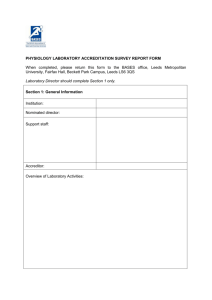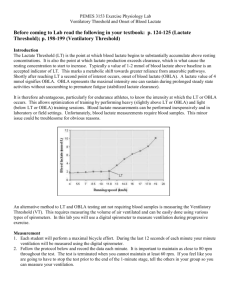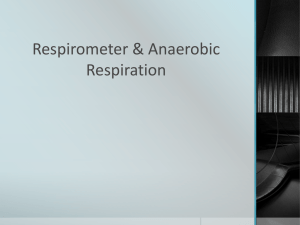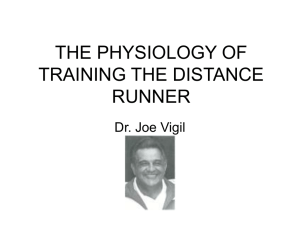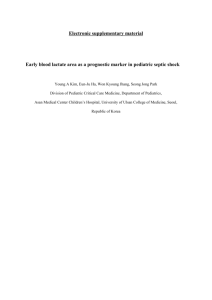1 Sao Paulo State University-UNESP. Department of Physical
advertisement
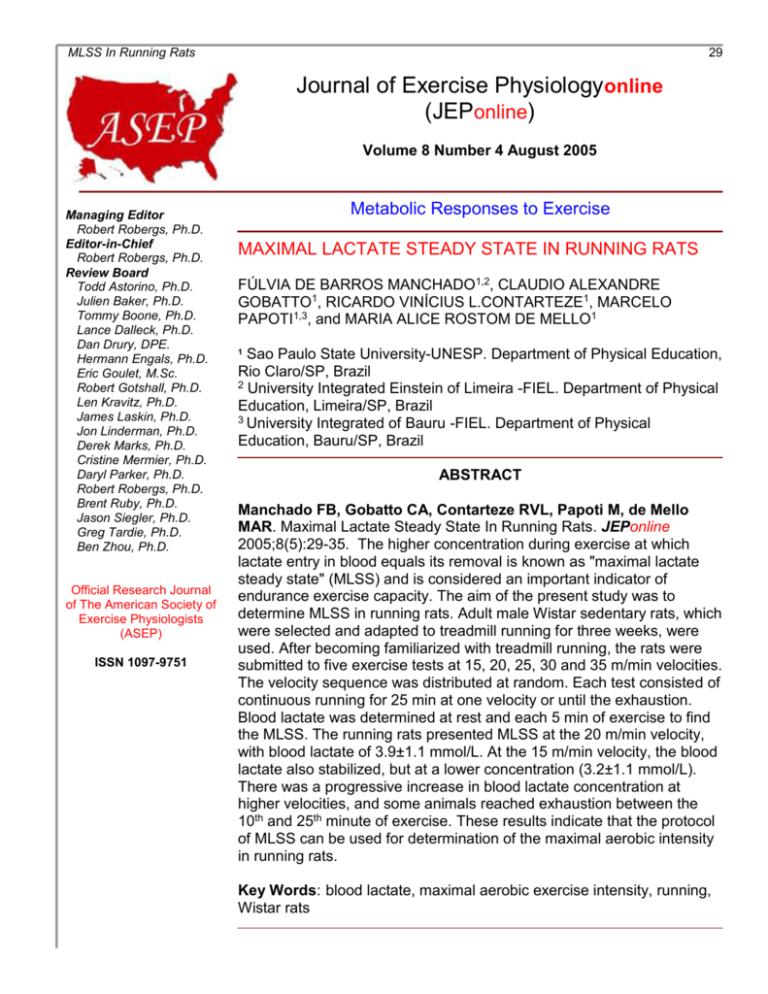
MLSS In Running Rats 29 Journal of Exercise Physiologyonline (JEPonline) Volume 8 Number 4 August 2005 Managing Editor Robert Robergs, Ph.D. Editor-in-Chief Robert Robergs, Ph.D. Review Board Todd Astorino, Ph.D. Julien Baker, Ph.D. Tommy Boone, Ph.D. Lance Dalleck, Ph.D. Dan Drury, DPE. Hermann Engals, Ph.D. Eric Goulet, M.Sc. Robert Gotshall, Ph.D. Len Kravitz, Ph.D. James Laskin, Ph.D. Jon Linderman, Ph.D. Derek Marks, Ph.D. Cristine Mermier, Ph.D. Daryl Parker, Ph.D. Robert Robergs, Ph.D. Brent Ruby, Ph.D. Jason Siegler, Ph.D. Greg Tardie, Ph.D. Ben Zhou, Ph.D. Official Research Journal of The American Society of Exercise Physiologists (ASEP) ISSN 1097-9751 Metabolic Responses to Exercise MAXIMAL LACTATE STEADY STATE IN RUNNING RATS FÚLVIA DE BARROS MANCHADO1,2, CLAUDIO ALEXANDRE GOBATTO1, RICARDO VINÍCIUS L.CONTARTEZE1, MARCELO PAPOTI1,3, and MARIA ALICE ROSTOM DE MELLO1 Sao Paulo State University-UNESP. Department of Physical Education, Rio Claro/SP, Brazil 2 University Integrated Einstein of Limeira -FIEL. Department of Physical Education, Limeira/SP, Brazil 3 University Integrated of Bauru -FIEL. Department of Physical Education, Bauru/SP, Brazil 1 ABSTRACT Manchado FB, Gobatto CA, Contarteze RVL, Papoti M, de Mello MAR. Maximal Lactate Steady State In Running Rats. JEPonline 2005;8(5):29-35. The higher concentration during exercise at which lactate entry in blood equals its removal is known as "maximal lactate steady state" (MLSS) and is considered an important indicator of endurance exercise capacity. The aim of the present study was to determine MLSS in running rats. Adult male Wistar sedentary rats, which were selected and adapted to treadmill running for three weeks, were used. After becoming familiarized with treadmill running, the rats were submitted to five exercise tests at 15, 20, 25, 30 and 35 m/min velocities. The velocity sequence was distributed at random. Each test consisted of continuous running for 25 min at one velocity or until the exhaustion. Blood lactate was determined at rest and each 5 min of exercise to find the MLSS. The running rats presented MLSS at the 20 m/min velocity, with blood lactate of 3.9±1.1 mmol/L. At the 15 m/min velocity, the blood lactate also stabilized, but at a lower concentration (3.2±1.1 mmol/L). There was a progressive increase in blood lactate concentration at higher velocities, and some animals reached exhaustion between the 10th and 25th minute of exercise. These results indicate that the protocol of MLSS can be used for determination of the maximal aerobic intensity in running rats. Key Words: blood lactate, maximal aerobic exercise intensity, running, Wistar rats MLSS In Running Rats 30 INTRODUCTION The determination of the transition zone from which metabolism shifts from predominantly aerobic to increased support from phosphagen and glycolytic energy systems, is of great interest for physical conditioning, physical evaluation, training and sport performance. As a consequence, a great number of investigations have been conducted in the last decades, resulting in different protocols for identification of this metabolic zone transition. Wasserman and McIlroy (1), first defined the term anaerobic threshold, in the sense that during exercise the abrupt increase of blood CO2 reflects a metabolic shift towards the anaerobic phosphagen and glycolytic energy systems. Kindermann et al. (2), after accomplishment of incremental exercise tests in well trained athletes, postulated the occurrence of a metabolic transition between aerobic and anaerobic systems at blood lactate concentrations between 2.0 and 4.0 mmol/L, with a marked anaerobic threshold at 4.0 mmol/L. In 1976, Mader et al. (3) suggested that the anaerobic threshold corresponds to a disproportional increase in blood lactate concentration in response to an exercise load. Later, Sjödin and Jacobs (4) and Heck et al. (5) considered the blood lactate level of 4.0 mmol/L as being the "onset of blood lactate accumulation”. Other simple protocols have been designed for determining the metabolic transition, among them the lactate minimum test described by Tegtbur et al. (6), the double bouts exercise method suggested by Chassain (7) based on values of heart rate (HR), VO2 and blood lactate delta, and the non-invasive but exhaustive critical power model proposed by Monod and Scherrer (8). In spite of this, the MLSS is considered the “gold standard” method for determination of aerobic/anaerobic metabolism transition (9-12). Since there are obvious limitations in the investigations with human beings, a significant number of studies involving exercise has been conducted in laboratory animals, mainly rats, and blood lactate concentration was used in many of them for the determination of exercise intensity. However, such procedure is hindered by the lack of information on the kinetics of blood lactate in these animals. In swimming rats, a series of experiments to analyze blood lactate kinetics during exercise were developed by our group. Initially, Gobatto et al. (13) demonstrated that the incremental test for swimming rats was not appropriate to anaerobic threshold determination because the blood lactate kinetics was linear. Later, a protocol for the maximal lactate steady state determination during continuous load exercise was described. The lactate concentration corresponding to the MLSS was 5.5 mmol/L for sedentary rats (14). The individual anaerobic threshold of swimming rats was obtained by Voltarelli et al. (15) based on the lactate minimum test originally described by Tegtbur et al. (6). Treadmill running is an important exercise mode for the evaluation of metabolism in rats. Pillis et al. (16) analyzed the blood lactate concentration in rats during a multistage treadmill exercise and calculated the anaerobic threshold (AT). In this study, the blood lactate showed a pattern similar to that described in human beings and the AT was observed at a velocity of 25 m/min, with a blood lactate concentration of 4.0 mmol/L. Recently, Billat et al. (17) also checked the mouse critical running speed using a non-invasive but exhaustive procedure. In spite the MLSS during continuous exercise being used to validate many protocols of physical evaluation and being considered the best method to identify the transition aerobic/anaerobic zone, the literature lacks information on studies for the determination of MLSS in running rats. This study was designed to determinate the maximal lactate steady state of sedentary rats submitted to treadmill running exercise. MLSS In Running Rats 31 METHODS Animals Eleven untrained male Wistar rats, 80 days old, weighing 250-320 g in the beginning of the experiment and 410-500 g at the end were selected and used for this study. During the whole experiment, the animals received water and commercial chow (Labina-Purina) ad libitum. The rats were housed in collective cages (5 animals per cage), in a room with a light cycle from 06.00 am to 6.00 pm, at 25C. All experiments involving the animals were conducted in conformance with the policy statement of the American College of Sports Medicine on Research with experimental animals. Selection Of Running Rats And Adaptation To The Treadmill Exercise The process of selection of running rats occurred for ten consecutive days, with the animals running to five minutes at 15 m/min. The animals that got to run nine or ten times were selected. Later, the animals were adapted to the treadmill. The adaptation consisted of keeping the rats to run for three weeks, 5 days/week, with duration and speed increased progressively. The purpose of the adaptation was to reduce potential exercise stress without promoting physical training adaptations. Experimental Procedure After becoming familiarized with treadmill running, the rats were submitted to five exercise tests in intensities equivalent to 15, 20, 25, 30 and 35 m/min velocities. Each animal participated in five experimental tests, each separated by 72 hrs. The sequence of velocities was distributed at random, and the same velocity was never used twice by the same rat. Each test consisted of continuous running for 25 min with one velocity or until exhaustion. Blood samples for lactate determinations were collected six times: before the beginning and every five min of exercise during the test. Blood Samples And Analysis Blood samples (25 L) were collected from a cut at the tail tip during the exercise tests and deposited in Eppendorf tubes (1.5 mL capacity) containing 50 L sodium fluoride (1 %). The lactate concentrations were determined in a lactate analyzer (YSI model 1500 SPORT). Calculations Individual graphics of the blood lactate responses during the exercise in the five different speeds were plotted to determine the MSSL. The highest intensity in which the increase on the blood lactate concentration was equal to or below 1 mmol/L from the 10th to the 25th minutes was considered as the maximal lactate steady state (10, 14). Statistical Analyses The statistical procedure consisted of one-way ANOVA. When necessary, the Newman-Keuls post hoc comparison test was used (18). In all cases, the statistical significance was set at P<0.05, and all data are presented as meanstandard deviation. RESULTS The animals presented maximal lactate steady-state at 3.91.1 mmol/L of blood lactate, at the velocity of 20 m/min. At 15 m/min, there was also stabilization of blood lactate, but in lower concentration (3.21.1 mmol/L). There was a progressive increase in blood lactate concentration with higher velocities, and some animals reached exhaustion between the 10th and 25th minute of exercise (Figure 1). 32 8 7 8 6 Blood lactate (mmol/L) Blood lactate (mmol/L) MLSS In Running Rats a 5 4 3 2 1 0 15 m/min rest 5 10 15 20 25 7 6 a a 5 3 2 20 m/min 1 0 30 rest 5 10 20 8 d Blood lactate (mmol/L) Blood lactate (mmol/L) c h g 15 25 30 Time (min) 8 6 a 4 Time (min) 7 a a f 5 4 3 2 25 m/min 1 d c 7 i 6 j j 5 4 3 2 30 m/min 1 0 0 rest 5 10 15 20 25 rest 30 5 15 20 25 30 Time (min) Time (min) 8 Blood lactate (mmol/L) 10 a 7 j e 6 5 4 3 2 35 m/min 1 0 rest 5 10 15 20 25 30 Time (min) Figure 1. Blood lactate concentrations during running exercise tests at 15 m/min (n=10), 20 m/min (n=11), 25 m/min (n=10), 30 m/min (n=10) and 35 m/min (n=8) velocities. Results are mean SD. In each panel, significant differences (P<0.05) are: a) vs. rest values; b) vs. rest and 5 min exercise values; c) vs. rest and 5 and 10 min exercise values; d) vs. rest and 5, 10 and 15 min exercise values; e) vs. rest and 5 and 15 min exercise values; f) vs. rest and 20 and 25 min exercise values; g) vs. rest and 15, 20 and 25 exercise values; h) vs. rest and 5 and 25 min exercise values; i) vs. rest and 5, 10 and 25 min exercise values; j) vs. rest and all other exercise time values. MLSS In Running Rats 33 DISCUSSION Blood lactate was identified as an indicator of an increased dependence on glycolyctic metabolism during exercise early last century (19). Ever since it has been used for the evaluation and prescription of physical training for human beings. Recently, the blood lactate has been used for to determination the exercise intensity in animals, but in spite of the importance, there are few studies on this subject in rats (13,15). The maximal lactate steady state can be used to detect the highest workload that can be maintained over time without continual blood lactate accumulation (5,9,20) because it represents the highest point of equilibrium between the production and removal of lactate (11). This parameter is considered a good indicator of the endurance exercise capacity (11,21) and the work rate associated to MLSS has been used in the assessment of an athlete´s endurance capacity (12,22). This study showed that the maximal lactate steady state can be easily observed in running rats and that blood lactate showed a pattern similar to that described in human beings during continuous exercise. The velocity associated to MLSS in our animals was 20 m/min. At higher intensities, the blood lactate showed sustained progressive increases and some rats did not tolerate the exercise. The value of maximal exercise intensity associated to aerobic condition observed in present study was lower than the speed observed by Pillis et al. (16) (25 m/min), obtained by a different protocol. These last authors determined the aerobic threshold in running rats using an incremental multistage treadmill exercise. The AT was estimated from individual plots of blood lactate vs. treadmill speed and the AT was considered the level of exercise intensity at which blood lactate concentration started to increase rapidly. Langfort et al. (23) also reported the same intensity for AT calculated as the speed of running corresponding to the individual breaking point of the lactate curve using the two-segment linear regression of sedentary rats (25 m/min). In spite of the fact that Pillis et al. (16) and Langfort et al. (23) were able to determine the anaerobic threshold in rats using a discontinued multistage treadmill exercise test, Gobatto et al. (13) did not find suitable blood lactate kinetics during an incremental swimming exercise protocol for rats. These same authors (14) observed the MLSS in continuous swimming test at different intensities, concluding that in submaximal continuous exercises, the blood lactate seems to show a better pattern of stabilization. The most important finding of our study was that the blood lactate concentration stabilized at 3.9 mmol/L, which is a similar to the values observed in experimental protocols with humans of different ages (5,24-26). Furthermore, the blood lactate levels obtained by the MLSS protocol was equivalent to the lactate concentration reported at the inflection point described by Pillis and Langfort in running rats, using the incremental protocol. During swimming, Gobatto et al. (14) reported the MSSL at higher values (5.5 mmol/L) at an intensity corresponding to 5% of the body weight, in sedentary rats. Voltarelli et al. (15) also found a similar intensity in an adapted swimming lactate minimum test for the metabolic transition, but at different blood lactate levels (7.17±0.16 mmol/L). This supports the hypothesis that the value of blood lactate concentration at the AT may be protocol dependent. MLSS In Running Rats 34 CONCLUSIONS In summary, untrained rats performing running exercise at 20m/min velocity allow a maximal blood lactate stabilization at 3.9 mmol/L. At lower intensities, the blood lactate concentration stabilization occurs at lower values. A progressive increase in blood lactate occurs at higher intensities, therefore, the MLSS test also can be used to determine the intensity of metabolic transition in running rats. ACKNOWLEDGEMENTS This study was supported by “Fundação de Amparo à Pesquisa do Estado de São Paulo”(FAPESP – Proc. 04/07070-5) and “Conselho Nacional de Desenvolvimento Científico e Tecnológico”(CNPq – Proc. 300270/2004-6). Grateful acknowledgment to Clarice Yoshio Sibuya, Eduardo Custódio and José Roberto Rodrigues da Silva, who provided essential help to the project. Address for correspondence: Fúlvia de Barros Manchado, Ms, Sao Paulo State University – UNESP, Department of Physical Education, Rio Claro, São Paulo, Brazil, 13506-900. Phone: +55 (19) 35264320; Fax: +55 (19) 3526432 ; E-mail: fbmanchado@yahoo.com.br REFERENCES 1. Wasserman K, McIlroy MB. Detecting the threshold of anaerobic metabolism in cardiac patients during exercise. Am J Cardiol 1964;14:844. Kindermann W, Simon G, Keul J. The significance of the aerobic-anaerobic transition for the determination of work load intensities during endurance training. Eur J Appl Physiol 1979;42:25-34. 2. Mader A, Heck, H. A theory of metabolic origin of the anaerobic threshold. Int J Sports Med 1986;7:45-65. 3. Sjödin B, Jacobs I. Onset of blood lactate accumulation and marathon running performance. Int J Sports Med 1981;2:23-6. 4. Heck H, Mader A, Hess G, Mücke S, Müller R, Hollmann W. Justification of the 4-mmol/L lactate threshold. Int J Sports Med, 1985;6:117-30. 5. Tegtbur U, Busse MW, Braumann KM. Estimation of an individual equilibrium between lactate production and catabolism during exercise. Med Sci Sports Exerc 1993;25:620-7. Chassain A. Méthode d’appréciation objetive de la tolérance de l’organisme á l’effort: application á la mensure des puissances de la frequence cardiaque et de la lactatémie. Science & Sports 1986;1:41-8. 6. Monod H, Scherer J. The work capacity of a synergic muscular group. Ergonomics 1965;8:32938. Beneke R. Anaerobic threshold, individual anaerobic threshold, and maximal lactate steady state in rowing. Med Sci Sports Exerc 1995;27(6):863-7. 7. Beneke R. Methodological aspects of maximal lactate steady state-implications for performance testing. Eur J Appl Physiol 2003;89:95-9. 8. Billat VL, Siverent P, Py G, Korallsztein J-P, Mercier J. The concept of maximal lactate steady state: a bridge between biochemistry, physiology and sport science. Sports Med 2003;33(6):407-26. 9. Baldari C, Guidetti L. A simple method for individual anaerobic threshold as a predictir of maximal lactate steady state. Med Sci Sports Exerc 2000;32:1798-802. 10. Gobatto CA, Kokubun E, Sibuya CY, Mello MAR. Efeitos da desnutrição protéico-calórica e do treinamento físico na produção de ácido lático em ratos machos adultos após teste de cargas progressivas. Resultados preliminares. Ciência e Cultura. 1991;43:725-6. MLSS In Running Rats 35 Gobatto CA, Mello MAR, Sibuya CY, Azevedo JRM, Santos L A, Kokubun E. Maximal lactate steady state in rats submitted to swimming exercise. Comp Biochem Physiol 2001;130 A:21-7. 11. Voltarelli FA, Gobatto CA, Mello MAR. Determination of anaerobic threshold in rats using the lactate minimum test. Braz J Med Biol Res 2002;35:1-6. 12. Pillis W, Zarzeczny R, Langfort J, Kaciuba-Uscilko H, Nazar K, Wojtyna J. Anaerobic threshold in rats. Comp Biochem Physiol 1993;106A:285-9. 13. Billat VL, Mouisel E, Roblot N, Melki J. Inter- and intra-strain variation in mouse critical running speed. J. Appl. Physiol 2005; 98(4):1258-63. Dawson-Saunders B, Trapp RG. Basic and clinical biostatistic. Appleton and Lange, East Norwalk, Connecticut, 1994. 14. Hill AV, Long CNH, Lupton H. Muscular exercise, lactic acid, and the supply and utilization of oxygen: parts IV-VI. Proc Roy Soc B 1924;97:84-138. 15. Pringle JSM, Jones A M. Maximal lactate steady state, critical power and EMG during cycling. Eur J Appl Physiol 2002;88:214-26. 16. Jones AM, Carter H. The effect of endurance training on parameters of aerobic fitness. Sports Med 2000; 29:373-6. 17. Almarwaey OA, Jones AM, Tolfrey K. Maximal lactate steady state in trained adolescent runners. J Sports Sci 2004;22(2):215-25. Langfort J, Zarzeczny R, Pillis W, Kaciuba-Uscilko H, Nazar K, Porta S. Effect of sustained hyperadrenalinemia on exercise performance and lactate threshold in rats. Comp Biochem Physiol 1996;14 A:51-5. 18. Billat VL, Dalmay F, Antonini MT, A method for determining the maximal steady state of blood lactate concentration from two levels of submaximal exercise.ort science. Eur J Appl Physiol 1994;69:196-202. Beneke R, Heck H, Schwarz V, Leithauser R. Maximal lactate steady state during the second decade of age. Med Sci Sports Exerc 1996;28:1474-8. 19. Billat VL, Gratas-Delamarche A, Monnier M, Delamarche P. A test to approach maximal lactate steady-state in 12-years old boys and girls. Arch Physiol Biochem 1995;103:65-72.

